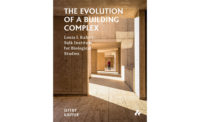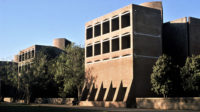Review of 'Our Days Are Like Full Years: A Memoir with Letters from Louis Kahn'
By Harriet Pattison

Our Days Are Like Full Years: A Memoir with Letters from Louis Kahn, by Harriet Pattison. Yale University Press, 438 pages, $45.
Landscape architect Harriet Pattison died on Monday, October 2. She was 94. She collaborated with Louis Kahn on several projects including the Kimbell Art Museum in Fort Worth, Texas, and Franklin D. Roosevelt Four Freedoms Park on Roosevelt Island in New York. Her complicated relationship with Kahn was revealed in a 2003 documentary, My Architect, by her son with Kahn, Nathaniel Kahn, her only survivor. She would go on later to detail her 15-year-long life with the much-admired architect in a 2020 memoir, Our Days Are Like Full Years: A Memoir with Letters from Louis Kahn, reviewed by RECORD below.
If you ask architects today whose work they most revere, “Louis Kahn” is a constant reply. Nearly half a century after his death, his architecture maintains a powerful hold on the imaginations of younger generations of practitioners. Yet the man who created buildings of timeless monumentality and ethereal light lived much of his life on shaky ground. His firm in Philadelphia teetered financially, his clients were often fickle, his travel schedule was punishing—and, at the height of his career, his family was splintered among three households: one with his wife and daughter Sue Ann, and two others with the women who each had a child with him.
The 2003 Oscar-nominated documentary, My Architect, by his son, Nathanial Kahn, blew the lid off this domestic drama, though did so tenderly. Even earlier, in 1997, the architect Anne Tyng had published a collection of Kahn’s letters to her, written in 1953–54, when she left his office for Rome, to secretly give birth to their daughter, Alexandra Tyng. There have been a number of books about Kahn since—Wendy Lesser’s 2017 biography, You Say to Brick, in particular, knit together Kahn’s public achievements and private tumult. Now there is one more perspective, from the second woman, Harriet Pattison, the mother of Nathaniel. Titled Our Days Are Like Full Years, it is a handsomely illustrated volume of Kahn’s love letters to her during the last 15 years of his complicated—and architecturally triumphant—life, salted with photographs, sketches, and her own memories.
Kahn’s letters to Tyng in Rome were deeply loving, but also crammed with architectural ideas and details as he kept her apprised of projects, and sometimes sought her sketches and advice. Tyng was in the first class of women admitted to Harvard’s GSD and was the only woman licensed as an architect in Pennsylvania in 1949. With her brilliant intellect, particularly for math and geometry, she and Kahn collaborated closely; she was essential, for example, to the design of the innovative ceiling of the Yale Art Gallery (1953), the first building to win him wide acclaim. After the birth of their child, Tyng returned to Kahn’s office and their love affair resumed, though the relationship became platonic, she wrote, when she realized Kahn had a new extramarital interest.
That likely was Pattison (according to Lesser, Kahn had at least one other serious affair). Pattison met the architect at a 1958 Christmas party at the Esherick Studio outside Philadelphia (which Kahn had designed with Tyng), brought by her date, Robert Venturi. She was educated at the Yale School of Drama in set design, and eventually moved to Philadelphia to study piano. When they met, she had just turned 30 and Kahn was 58. By late the following year, he declared in a letter, “You are the only one I ever loved,” and the year after that: “Someday my darling our love will be in our little ones.” But when Pattison told him in the spring of 1962 that she was pregnant, Kahn blurted, “Not again!” and fell silent. He refused to get a divorce.
It’s hard not to bring a 2021 viewpoint to the twists in their lives; today an unmarried mother doesn’t live in the social shadows as Pattison and Tyng both did, suffering personal and serious professional slights. And we are quick to excoriate the man with the power. Yet, then, both women—as well as Kahn’s wife, Esther, who worked to support him financially for decades—believed in his genius as an architect and understood that his work came first: till late at night and on weekends and holidays. Pattison loved him profoundly and never stopped wishing and pressing Kahn to leave his marriage; but, as she writes in the book, “he seemed able to put different parts of his life in different places in his mind . . . a kind of living equivalent of the way he sought a strong distinction between spaces in his architecture.”
Kahn arranged Pattison’s exile to Vermont, with baby Nathaniel, to apprentice for landscape architect Dan Kiley. After a year, she and their son returned to Philadelphia, where she earned a master’s degree in landscape architecture at the University of Pennsylvania. She worked for a firm in the same building as Kahn’s firm and intermittently for Kahn, too (off in a closetlike space in case of a surprise visit from Esther); key among her projects was the site planning and early landscape design for the Kimbell Art Museum.
Those were the glory years for the architect, with work under way not only on the Kimbell but the Salk Institute, and on the enormous projects on the Asian subcontinent, the National Assembly in Dhaka and the Indian Institute of Management in Ahmedabad. Kahn’s letters from his busy travels include charming sketches and site plans for various projects, as well as philosophical musings and expressions of his ardor: “As much as my work is my life, it would be little without your love.” Facsimiles of the original handwritten correspondence are included in the book, a collage of picture postcards and yellowed stationery from exotic hotels.
For more than a decade, Kahn journeyed frequently to Pakistan and India, writing Pattison about the banalities of travel, the progress of meetings, and often deep frustrations: insolent officials; fraught negotiations; contracts not signed; constant money worries (and apologies for not sending some cash). He worked and reworked projects that were never built; when he was fired from designing the President’s Estate in Islamabad, his confidence was shaken. “Dearest Harriet, I feel that I have lost my mastery and doubt even if I ever had it.” He endured dysentery, unbearable heat, and the monsoons that brought snakes and rats out of their holes in the earth. Yet he developed warm friendships with Indian colleagues such as Balkrishna Doshi, and he longed to extend his stays to better oversee the construction of what are his masterpieces in Dhaka and Ahmedabad.
His flight itineraries were crazy (one trip home, he wrote Pattison, was routed from Karachi to Moscow to Warsaw to London), and the missed connections, interminable delays, and sleeplessness are exhausting just to read about, and ultimately the travel killed Kahn, who collapsed on his way home from Dhaka in 1974. He was 73.
Kahn never tore down the architecture that separated the rooms of his complicated life. But his expressions of love in the letters and his devotion to Nathaniel are extremely poignant. “I am so lonely for the two of you,” was a frequent sign-off from a faraway hotel. On his occasional evenings at Pattison’s house, she would mix his martini and then fix dinner while Kahn played, with pleasure, on the floor with his son, a momentary replica of normal family life. Then, very late, Pattison would drive him to the corner of the street where he lived with his wife.
Kahn was a loving father to Alexandra Tyng, too, and as a bold teenager, she pulled down the walls, and the three Kahn children got to know each other while their father was still alive. Today, they come together to fight for his legacy, most recently to protest the Indian Institute of Management’s plan to raze part of Kahn’s extraordinary campus. And now Pattison, 92 (and the only of the three mothers still alive) has provided new pieces of the Kahn puzzle, though the picture of his life will never be completely understood.



